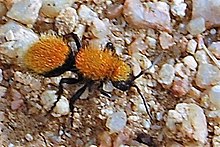Dasymutilla
| Dasymutilla | |
|---|---|

| |
| Dasymutilla sp. | |
| Scientific classification | |
| Kingdom: | |
| Phylum: | |
| Class: | |
| Order: | |
| Suborder: | |
| Superfamily: | |
| Family: | |
| Subfamily: | |
| Genus: | Dasymutilla Ashmead, (1899)
|
| Species | |
|
~200 species; see text | |
The wasp genus Dasymutilla belongs to the family Mutillidae. The females of the genus are well known for their painful sting, which is where many gain their common name, Cow Killer. Females are wingless and resemble large ants while the males possess wings. The larvae are external parasites to various types of ground-nesting Hymenoptera.
Selected Species
- D. alesia
- D. archboldi
- D. arenivaga
- D. asopus
- D. aureola
- D. bioculata
- D. californica
- D. calorata
- D. chattahoochei
- D. chiron
- D. chisos
- D. coccineohirta
- D. creon
- D. creusa
- D. dilucida
- D. foxi
- D. gibbosa
- D. gloriosa (Thistledown Velvet Ant)

- D. gorgon
- D. heliophila
- D. klugii
- D. lepeletierii
- D. magnifica (Red Velvet Ant)
- D. meracula
- D. monticola
- D. mutata
- D. nigricauda
- D. nigripes
- D. nitidula
- D. nocturna
- D. nogalensis
- D. occidentalis (Cow Killer)
- D. pyrrhus
- D. quadriguttata
- D. sackenii
- D. scaevola
- D. sicheliana
- D. thetis
- D. vesta
- D. vestita
Defenses
Not only are wasps in this genus equipped with a powerful venomous sting, together they form one of the largest Müllerian mimicry complexes in North America. There is an Eastern Mimicry Ring which includes D. occidentalis and D. vesta and there is the Western Mimicry Ring which includes many other species. The effect is to warn off predators by shared aposematic coloration without requiring inexperienced predators to taste and be stung by members of each species separately.[1][2]
Aside from aposematic coloration, they can produce a loud squeaking noise (stridulation) which also warns potential predators. Their exoskeleton is remarkably strong; experiments concluded that 11 times more force was needed to crush the exoskeleton of a female velvet ant than that of a honey bee.[3]
References
- ^ Wilson, Joseph S.; Williams, Kevin A.; Forister, Matthew L.; von Dohlen, Carol D.; Pitts, James P. (11 December 2012). "Repeated evolution in overlapping mimicry rings among North American velvet ants". Nature Communications. 3 (1): 1272. Bibcode:2012NatCo...3E1272W. doi:10.1038/ncomms2275. PMID 23232402.

- ^ Wilson, Joseph S.; Jahner, Joshua P.; Forister, Matthew L.; Sheehan, Erica S.; Williams, Kevin A.; Pitts, James P. (August 2015). "North American velvet ants form one of the world's largest known Müllerian mimicry complexes". Current Biology. 25 (16): R704–R706. doi:10.1016/j.cub.2015.06.053. PMID 26294178.

- ^ Gall, Brian G.; Spivey, Kari L.; Chapman, Trevor L.; Delph, Robert J.; Brodie, Edmund D.; Wilson, Joseph S. (June 2018). "The indestructible insect: Velvet ants from across the United States avoid predation by representatives from all major tetrapod clades". Ecology and Evolution. 8 (11): 5852–5862. doi:10.1002/ece3.4123. PMC 6010712. PMID 29938098.
- Evans, Arthur V. (2007). Field Guide to Insects and Spiders of North America. Sterling Publishing Co. p. 371. ISBN 978-1-4027-4153-1.
- "List of Dasymutilla". Retrieved 2008-09-13.
- "Genus Dasymutilla". Retrieved 2008-09-13.
- "San Diego Natural History Museum Dasymutilla sp". Retrieved 2008-09-13.
